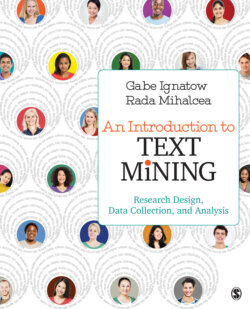Читать книгу An Introduction to Text Mining - Gabe Ignatow - Страница 13
На сайте Литреса книга снята с продажи.
Predicting the Stock Market With Twitter
ОглавлениеBollen, J., Mao, H., & Zeng, X.-J. (2011). Twitter mood predicts the stock market. Journal of Computational Science, 2(1), 1–8.
The computer scientists Bollen, Mao, and Zeng asked whether societies can experience mood states that affect their collective decision making, and by extension whether the public mood is correlated or even predictive of economic indicators. Applying sentiment analysis (see Chapter 14) to large-scale Twitter feeds, Bollen and colleagues investigated whether measurements of collective mood states are correlated to the value of the Dow Jones Industrial Average over time. They analyzed the text content of daily Twitter feeds using OpinionFinder, which measures positive versus negative mood and Google Profile of Mood States to measure mood in terms of six dimensions (calm, alert, sure, vital, kind, and happy). They also investigated the hypothesis that public mood states are predictive of changes in Dow Jones Industrial Average closing values, finding that the accuracy of stock market predictions can be significantly improved by the inclusion of some specific public mood dimensions but not others.
Specialized software used:
OpinionFinder
http://mpqa.cs.pitt.edu/opinionfinder
Text analysis involves systematic analysis of word use patterns in texts and typically combines formal statistical methods and less formal, more humanistic interpretive techniques. Text analysis arguably originated as early as the 1200s with the Dominican friar Hugh of Saint-Cher and his team of several hundred fellow friars who created the first biblical concordance, or cross-listing of terms and concepts in the Bible. There is also evidence of European inquisitorial church studies of newspapers in the late 1600s, and the first well-documented quantitative text analysis was performed in Sweden in the 1700s when the Swedish state church analyzed the symbology and ideological content of popular hymns that appeared to challenge church orthodoxy (Krippendorff, 2013, pp. 10–11). The field of text analysis expanded rapidly in the 20th century as researchers in the social sciences and humanities developed a broad spectrum of techniques for analyzing texts, including methods that relied heavily on human interpretation of texts as well as formal statistical methods. Systematic quantitative analysis of newspapers was performed in the late 1800s and early 1900s by researchers including Speed (1893), who showed that in the late 1800s New York newspapers had decreased their coverage of literary, scientific, and religious matters in favor of sports, gossip, and scandals. Similar text analysis studies were performed by Wilcox (1900), Fenton (1911), and White (1924), all of whom quantified newspaper space devoted to different categories of news. In the 1920s through 1940s, Lasswell and his colleagues conducted breakthrough content analysis studies of political messages and propaganda (e.g., Lasswell, 1927). Lasswell’s work inspired large-scale content analysis projects including the General Inquirer project at Harvard, which is a lexicon attaching syntactic, semantic, and pragmatic information to part-of-speech tagged words (Stone, Dunphry, Smith, & Ogilvie, 1966).
While text mining’s roots are in computer science and the roots of text analysis are in the social sciences and humanities, today, as we will see throughout this textbook, the two fields are converging. Social scientists and humanities scholars are adapting text mining tools for their research projects, while text mining specialists are investigating the kinds of social phenomena (e.g., political protests and other forms of collective behavior) that have traditionally been studied within the social sciences.
